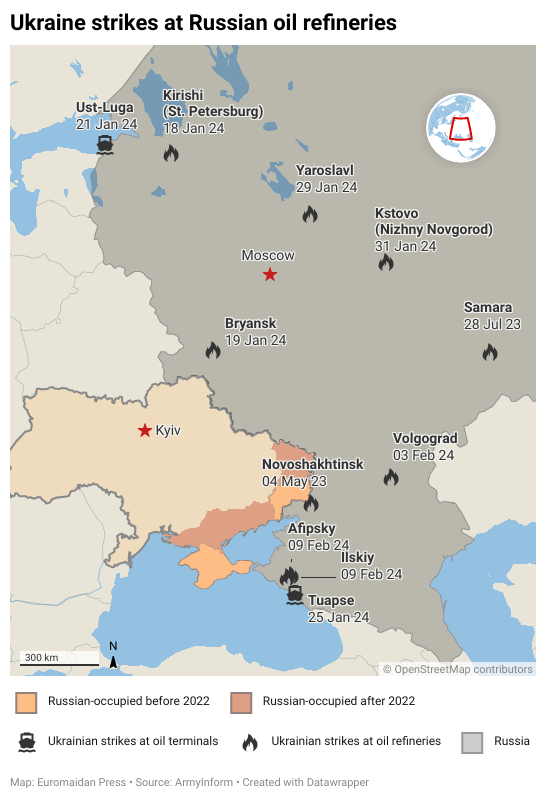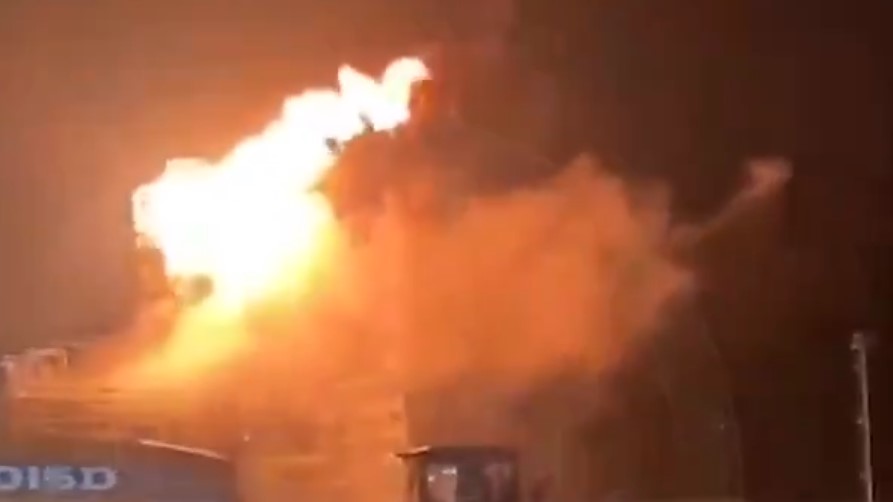Today, a significant percentage of money in the Russian budget comes from selling oil and petroleum products – according to various estimates, this figure ranges from 25-35%.
So, during the full-scale invasion in 2022, Russian analysts write that Russian exports of Russian oil, petroleum products, and gas reached $383.7 billion, 43% more than in 2021, based on data from the Federal Customs Service of the Russian Federation. There is no more recent official data yet.
This is an absolute record for 27 years – since 1995. In general, according to estimates by the Center for Research on Energy and Clean Air (CREA), since the start of the war, Russia has received €590 billion in revenues from the export of fossil fuels.
Today, there are about 30 large oil refineries and another 80 mini-refineries in Russia. The largest oil refineries in the Russian Federation are located in the cities of: Omsk, Kirishi (St. Petersburg), Ryazan, Kstovo (Nizhny Novgorod), Volgograd, Yaroslavl, Perm, Moscow, Tuapse.

As recent news shows, unexpectedly for the Putin regime (and Russian air defense), many of these plants have found themselves within striking distance of UAVs.
Officially, none of the Ukrainian security forces have taken responsibility for these incidents. Confirmations of Ukrainian strikes deep into the enemy’s rear, published by Ukrainian media with references to their own unnamed sources, are also not commented on by either the leaders or spokespersons of the Defense Forces.
Mysterious drones
Strikes by unknown UAVs on infrastructure facilities, defense industry plants, and oil refineries are becoming more frequent.
On 18 January 2024, UAVs attacked the St. Petersburg Oil Terminal, and on 21 January, the technological capabilities of Novatek at the Ust-Luga port, where millions of tons of the “blood of war” – diesel fuel and aviation kerosene – were produced annually.
On 19 January, tanks at an oil depot in Klintsy, Bryansk Oblast, were hit. And on 25 January, an oil refinery near Tuapse was successfully attacked, where the UAV hit important equipment.
https://twitter.com/EuromaidanPress/status/1753700435297243274
On 29 January, a drone attacked an oil refinery in the Russian city of Yaroslavl. According to the Russians, they could intercept the UAV, so it allegedly did not cause any damage. This is the first attack by “unknown drones” in the Yaroslavl region at a distance of about a thousand kilometers from Ukraine’s borders.
Already on 9 February, unmanned aerial vehicles struck the Ilsky and Afipsky oil refineries in the Krasnodar Territory.
https://twitter.com/EuromaidanPress/status/1755879458869858595
How Russia reacts
The Russians are hastily deploying air and missile defense systems around them to protect their refineries and oil depots. As military analyst Serhiy Berezutskyi said, according to information from the Russian media, the Russians are redeploying S-300 anti-aircraft missile systems, which were deployed on the islands of Iturup and Kunashir in the Far East, to position areas around St. Petersburg.
But the S-300 belongs to air defense systems; its purpose is to protect the rear from massive strikes by ballistic, aeroballistic and cruise missiles, strategic and tactical aircraft, as well as combat helicopters.
The relatively small UAV compared to aircraft and missiles has a low RCS (radar cross-section), and its low speed often does not allow powerful radars like the 76N6 or 36D6 to detect and reliably capture the target. Given that the latest UAVs overcome air defense zones at low and ultra-low altitudes, deploying S-300 divisions becomes pointless.

Pantsir divisions are also deployed around Moscow. At the same time, some Pantsirs were torn off the roofs of high-rise buildings in Moscow itself, indicating the inability to reliably cover the sky even on the approaches to the capital.
The Pantsir is quite well suited to combat small targets, including UAVs. But in reality, Pantsir can show itself well as part of object air defense when the UAV emerges practically on it.
However, its capabilities are drastically reduced when it needs to intercept a target at a distance of more than one kilometer from its position. In addition, as the experience of the war shows, Ukrainian UAVs are quite capable of destroying Pantsirs.
Potential for attacks
Russia has a large area, and saturating it with sufficient air defense systems or mobile fire groups is unrealistic.
Therefore, strikes, in particular using relatively inexpensive UAVs at oil and gas enterprises, cause millions of dollars in damage and are an example of a successful asymmetric response to the Russians.
According to the director of the Psycheya analytical center Serhiy Sapehin, among the components of ensuring the security of oil refineries in Russia, one of the main ones is cybersecurity. After all, hacking attacks on production can cause significant damage with minimal risks for those who attack.
The Tuapse oil refinery is at least the fourth fuel facility in Russia hit by Ukrainian long-range suicide drones over the last week. pic.twitter.com/2oTUWDcdSa
— Euromaidan Press (@EuromaidanPress) January 25, 2024
Therefore, according to Sapehin, Ukraine should weigh the best solution to cause critical damage to Russian oil refineries.
“Oil attacks” and their impact on geopolitics
Targeted attacks on energy infrastructure can cause much more deferred damage than blows to the front. Attacks on oil wells, refineries, and oil depots proved very successful and made a major contribution to the overall collapse of the German economy at the end of World War II.
As German Armaments Minister Albert Speer believed, technically, Germany was defeated on 12 May 1944, when due to massive Allied bombing, 90% of the factories producing synthetic fuel were destroyed.
In modern times, the first known UAV strike on an oil refinery occurred on 14 September 2019. It was an attack by drones on the world’s largest primary oil processing plant in Abqaiq in eastern Saudi Arabia and a refinery at the Khurais oilfield.
The attack caused a temporary halving of Saudi oil production (from 9.8 million barrels to 4.1 million barrels), accounting for 5% of global oil production. Responsibility for the attack was claimed by the Ansar Allah movement (Yemeni Houthis).
The attack caused serious damage to Saudi Arabia’s oil infrastructure and heightened geopolitical tensions in the Middle East. There was also a sharp spike in global oil prices – the increase in the price of Brent crude was the highest since 1991.
Western economic sanctions against the Kremlin economy are insufficiently effective, judging by Russia’s escalating offensive on Ukraine. According to various estimates, Russia’s share in the global oil export volume is about 11%, which brings insane profits to the invading country.
Targeted attacks on energy infrastructure can cause much more deferred damage than attacks on the front. Attacks on Russian oil refineries have already been felt by the global market. Thus, according to Bloomberg, the weekly volume of oil refining in Russia decreased to a minimum, reaching an almost two-month anti-record.
Related:




